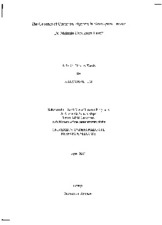| dc.creator | Kortum, Karen | |
| dc.date.accessioned | 2013-02-22T20:41:27Z | |
| dc.date.available | 2013-02-22T20:41:27Z | |
| dc.date.created | 2001 | |
| dc.date.issued | 2013-02-22 | |
| dc.identifier.uri | https://hdl.handle.net/1969.1/ETD-TAMU-2001-Fellows-Thesis-K68 | |
| dc.description | Due to the character of the original source materials and the nature of batch digitization, quality control issues may be present in this document. Please report any quality issues you encounter to digital@library.tamu.edu, referencing the URI of the item. | en |
| dc.description | Includes bibliographical references (leaves 19-21). | en |
| dc.description.abstract | Circadian biological clocks are found in virtually all organisms and function to generate daily rhythms. The circadian clock (built by one or more oscillators) controls rhythmicity in a wide range of processes, ranging from sleep/wake cycles in humans, photosynthesis in some plants, to reproduction in fungus and other eukaryotes. One organism, Neurospora crassa, displays an easily observed and assayable circadian rhythm in asexual spore production, conidiation, and is an excellent model for understanding the molecular and biochemical basis of circadian rhythms. Studies in Neurospora have identified the frequency (frq) gene as a central component of the fungal clock. Under most growth conditions, rhythmic development is absent in strains lacking a functional FRQ protein. However, under some conditions, rhythmic conidiation can be observed in a FRQ-null strain. This residual rhythmicicty was noticed early on, but went essentially ignored until recent experiments demonstrated rhythms in cultured FRQ-null strains grown in 12 hour temperature cycles in constant darkness. These data suggested that the FRQ-based oscillator is not the only oscillator in the cell and led to our hypothesis that the clock system is composed of more than one oscillator that can function to generate rhythms. To test this hypothesis, I have created random mutations in a FRQ-null strain and assayed for loss of rhythmicity in the temperature cycles. Fourteen mutant strains were identified that met these criteria. It is expected that some of these mutations will identify genes that function in the temperature-dependent oscillator. | en |
| dc.format.medium | electronic | en |
| dc.format.mimetype | application/pdf | |
| dc.language.iso | en_US | |
| dc.publisher | Texas A&M University | |
| dc.rights | This thesis was part of a retrospective digitization project authorized by the Texas A&M University Libraries in 2008. Copyright remains vested with the author(s). It is the user's responsibility to secure permission from the copyright holder(s) for re-use of the work beyond the provision of Fair Use. | en |
| dc.subject | biomedical science. | en |
| dc.subject | Major biomedical science. | en |
| dc.title | The genetics of circadian rhythms in Neurospora crassa : do multiple oscillators exist? | en |
| thesis.degree.department | biomedical science | en |
| thesis.degree.discipline | biomedical science | en |
| thesis.degree.name | Fellows Thesis | en |
| thesis.degree.level | Undergraduate | en |
| dc.type.genre | thesis | en |
| dc.type.material | text | en |
| dc.format.digitalOrigin | reformatted digital | en |


